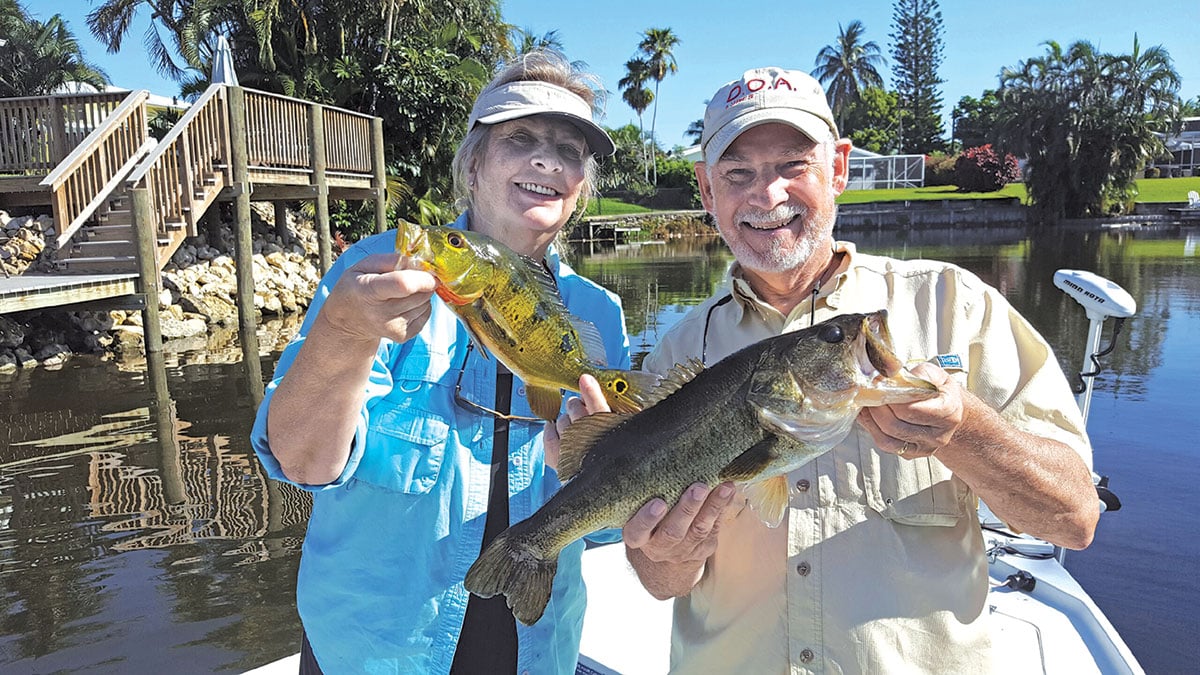It’s beginning to look a lot like travel season!
South Florida has thousands of ponds, lakes and an extensive spider web of canals stuffed with largemouth bass, most of them offering easy fishing access. Fishing with a guide is always a good bet for success like the day my wife Linda and I fished with Capt. Patrick Smith of Swamp to Sea guide service for a mixed bag of largemouth bass and colorful peacock bass in Palm Beach County’s Lake Ida. That day Patrick also got my attention with tales of amazing bass fishing in the Everglades along Highway 75, more commonly known as Alligator Alley connecting Fort Lauderdale to Naples and Fort Myers.
For snowbirds the timing is perfect because the Alley is at its bass-fishing best in winter and spring because it’s the dry season for this freshwater side of the Everglades, which lowers the water level of the sawgrass prairies. To survive the bass must move with the receding water into the deeper canals. To say they are stacked up is an understatement. My son Rich and I fished Alligator Alley and caught so many bass in the Miami Canal we lost count, but guesstimated at 135 in less than two hours while chucking rubber worms and surface poppers rigged with a weed guard to avoid getting hung up on the large gardens of water lilies and spatterdock. Lower water levels happen in virtually every south Florida pond and lake.

The where-to-go list of choices is extensive and mind boggling, but Steve Kantner, nicknamed the Land Captain because of his many years of experience fishing from shore and canoe throughout most of south Florida, wrote the Ultimate Guide to Fishing South Florida on Foot, a terrific handbook published by Stackpole (stackpolebooks.com) that will point any vacationer in the right direction for inland and back-country fresh and saltwater fishing too.
Although largemouth bass are the main contender, depending on exactly where you fish, there’s a lot more to catch than just bass. I already mentioned peacock bass, the colorful transplant from Brazil’s Amazon River Basin introduced by the Florida’s FWC to control small invasive fish released illegally into south Florida waters from aquariums. The Mayan cichlid (sic-lid) is another colorful transplant. Unlike largemouth or peacock bass, cichlids bore down deep fighting like tough bulldogs making them an absolute blast on light tackle. As a kid, you may have had a pet Oscar in your aquarium and it probably didn’t grow too big. In south Florida canals this member of the cichlid family frequently exceeds a pound and can get close to 2 pounds. Cichlids and oscars take small plugs and rubber worms aggressively.
Another exotic, the Clown Knifefish, has a string of large black dots along its silvery body, which is shaped somewhat like the profile of a knife. The large black dots are surrounded with a gold-tinted ring that kind of looks like a circus clown’s costume. They fight well, but are not as easy to catch as bass. Other fish you may catch include the Florida gar, a smallish member of the gar family with beautiful color patterns of green, brown, beige and white – and set of wicked teeth. Florida’s bluegill sunfish look like their northern counterparts only on steroids. They’re not all jumbo size, but expect to be surprised with a platter-size panfish every so often, especially if you fish Miami/Dade, and they’re the most fun when caught on small surface poppers. The visual strikes and frequent misses will make even the most reserved angler laugh right out loud.
You may also run into a mudfish, aka bowfin. In dark-water canals the mudfish lives up to its name and is a dull dark brown. It fights like heck and can get up to 10 pounds or so, and their teeth are wicked almost like a bluefish. In clear water, it wears a more distinguished bright suit of green and brown that resembles a largemouth bass.
In areas where freshwater canals are connected to, or near, saltwater the catch options expand to include baby tarpon and snook, such as along the famous Tamiami Trail. The tarpon are often really small with great big happy eyes and they jump like crazy and at this 1- to 5-pound stage in their lives. Snook also get airborne adding even more dazzle to the day’s fishing, but it’s their tremendous hard-whacking strike and bar-brawling fight that makes them so exciting.
Besides hiring a guide, you can fish on your own by renting a kayak, or if you do the I-95 thing bring your own ‘yak on top of your family SUV. Kayaks can be used in thousands of places including many state, county and town parks, and in condo ponds if the HOA allows. If you’re going at it solo, be sure to get your license first at myfwc.com.
There are several guides around south Florida that specialize in fishing for largemouth and peacock bass. My experiences with Capt. Patrick Smith (swamptosea.com) have been excellent – he’s friendly, knowledgeable and absolutely loves fishing. On the West Coast, check out guide/book author Joe Mahler (joemahler.com) and guide/writer Debbie Hanson (shefishes2.com).



